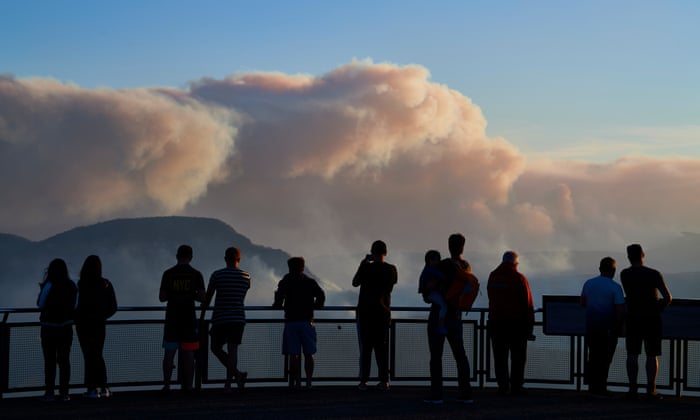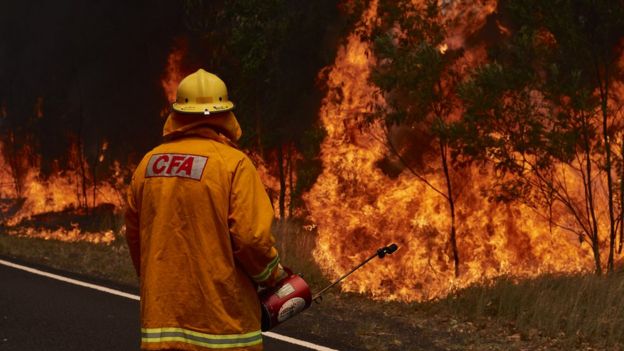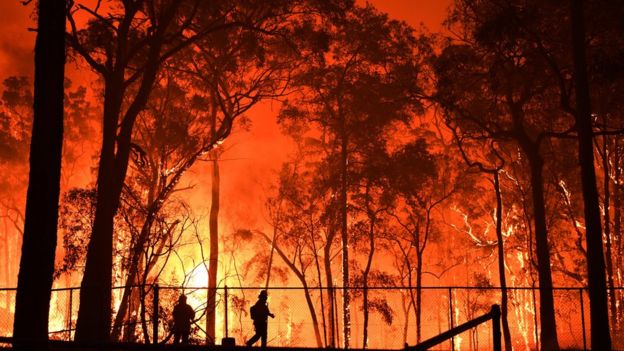Where There's Wildfire There's Chaos
"We're all feeling it."
"As fire seasons ramp up and get longer -- and they definitely seem to be doing that, the science tells us that -- it places more demand on aircraft to support the firefighting. And it's only one part of the equation."
"I suspect we're all becoming more nervous. We're keeping a watchful eye on it."
Richard Alder, general manager, National Aerial Firefighting Center, Australia
"It's coming from all over."
"Fires are affecting climates and places they never used to affect."
John E. Gould, head, 10 Tanker
"[That has forced firefighting] to be a global effort, not a state or national effort."
"It's not just a firefighting issue. We need to be more critical of our planning decisions. We need to examine building in bush-fire-prone areas."
"People love living in the bush, but as the bush is becoming more vulnerable, is that viable?"
Stuart Ellis, chief executive, Australasian Fire and Emergency Service Authorities Council
 |
| People view smoke from bushfires in the Blue Mountains, west of Sydney, on Wednesday. NSW is suffering its worst period of air pollution on record, while Qld faces a renewed fire threat and similar smoke pollution. Photograph: Brett Hemmings/Getty Images |
Timely observation, that last one. Was it not at one time taken for granted that building and living in weather-sensitive areas like floodplains prone to flooding, and areas surrounded by dry bush were susceptible to disaster, making life at times very interesting for the people who insist on spectacular natural views? Municipalities were given to refusing permits to build on these areas that had the potential to pose great danger when nature's plans were up-ended.
Now fire seasons have been extended, and when wildfires erupt they are hotter and tend to burn faster and spread speedily and effortlessly. Within days of the last fires to hit California, major fires erupted in Sydney, Australia. Countries that once managed their wildfires not needing outside assistance now see themselves inviting firefighters from abroad to join their battle.
Chile, Bolivia and Cyprus competed for plane and helicopter contracts to cope with their intensifying fires, stretching capacity for companies specializing in firefighting aircraft contracting, increasing worldwide anxiety for local fire officials. Scientists have declared that the age of fire has struck, systems designed to contain regional wildfires are pushed to their limits. Residents whose homes become endangered demand assistance from the air, not satisfied with mere ground-fighting.
 |
| Fire crews are battling to manage blazes ahead of predicted heat Getty Images |
A reserve fund was created by the European Union this year to aid in contracting for firefighting aircraft for deployments across national borders. The only Boeing 747 water bomber in the world was leased by Bolivia to fight Amazon fires in August. That plane had been deployed in 2015 in Israel, Chile in 2017 and California in 2018. South Korea has inquired with firefighting companies such as 10 Tanker Air Carrier in New Mexico, and Indonesia borrowed an Australian air tanker from Coulson Aviation in Canada.
These companies are now looking to double the size of their fire-fighting contract fleets, while looking to encounter year-long world blazes. In Australia, the country has become a test case of dry-climate runaway wildfires. Arid and expansive, its large cities sprawling into wilderness areas, the country is particularly susceptible to wildfires, all the more so with a sharp shift in precipitation events leading to lengthy droughts, to exacerbate natural defences.
 |
| Specialists from Ontario's Ministry of Natural Resources and Forestry are assisting in Australia. |
Forests become tinderboxes awaiting sparks in the wake of fewer rain events where traditionally dry areas simply become drier as time goes on. Over a thousand firefighters battled over 120 blazes in four states in the last few weeks where in some areas no rainfall of any significance is expected into the new year. Overlapping and intensified demands worldwide have become the stuff of nightmares for fire officials around the world.
When super blazes quickly spread with powerful winds, the best plans of countering them by ground crews or aircraft come to nothing. Supercharged winds burned the town of Paradise, California last year, when water bombers were unable to drop payloads, shoved too high for practical use by the prevailing winds. Fire management costs and aircraft use have led to soaring costs. Chile spent three times more on firefighting from 2014 to 2018 than the previous five years.
All of the large air tankers the U.S. Forest Service plans to use through to 2022 are from private contractors. The worse it may become for Australia the more that fires surge into the fall for California, when time-sharing of fire-fighting resources become critical through shortages and prior contracting-out, even as planes are being modified for greater effectiveness, such as the 737 fireliner that carries 15,000 liters of liquid that California just bought.
 |
| Fires continue to burn across New South Wales and Queensland EPA |
Labels: Firefighting, Global Cooperation, Wildfires

<< Home